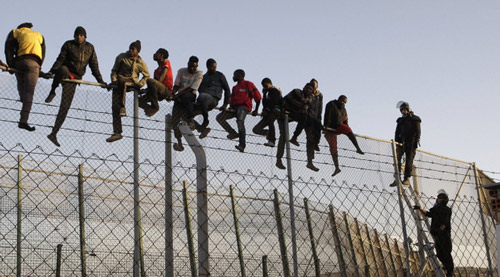This Mind-Boggling Commercial Fishing Practice Is Robbing Alaska’s Anglers

Lawmakers in Alaska are considering legislation that would reign in one of the most controversial and destructive forms of modern commercial fishing. Known as trawling, this technique involves huge boats dragging even bigger nets through the ocean, and often, along the seafloor, scraping and scooping up everything in their path.
This is a highly efficient way to catch gobs of fish. It also creates massive bycatch — a term for the species that aren’t being targeted but are caught (and killed) anyway. Every year while targeting pollock, flounder, and other marketable fish, trawlers operating off Alaska’s coast legally catch, kill, and toss overboard tens (if not hundreds) of thousands of salmon, along with millions of pounds of halibut, herring and crab, and occasionally, some killer whales.
Countless more forage fish and other species end up in trawlers’ nets as well. Then there’s the larger, more insidious damage to underwater habitats caused by dragging giant nets for miles along the ocean floor. This comes at a time when some of Alaska’s key fish populations are suffering, and it directly leads to fewer opportunities for sport and subsistence fishermen. That’s why the majority of Alaskans now support a ban on trawling — or at the very least, some changes in how the industry is regulated.
This includes David Bayes, a charter captain based in Homer and the guest on this week’s episode of the Outdoor Life Podcast. Bayes, who also holds a biology degree, has for years been raising public awareness around the unsustainable impacts that trawlers are having on Alaska’s marine resources. He’s been impacted personally, since the number of days he’s allowed to fish for halibut has declined, while the share of halibut that trawlers are allowed to waste as bycatch has stayed the same or even increased.
The bill currently under consideration in Alaska would ban certain forms of trawling in state waters. It could be a good start toward some common-sense regulations, Bayes says. But he adds that more change is needed at the federal level, too.
Why are we allowing one segment of industry to waste our marine resources while forcing everyday fishermen to bear the brunt of conservation?
Bayes explains that the trawling issue is often seen as a hairy one, due to all the bureaucracy surrounding federal fishing regulations and the politics that drive them. From a sportsman’s perspective, it all revolves around a simple question: Why are we allowing one segment of industry to waste our marine resources while forcing everyday fishermen to bear the brunt of conservation?
“That brings you into this conversation of, well, fish are a public resource. And this underwater habitat is public land,” Bayes says. “That catches the attention of everybody, both [in Alaska] and nationwide.”
Waste Not, Want Not
In 2024, the state of Alaska signed an agreement with Canada placing a seven-year moratorium on all king salmon fishing along the Yukon River and its Canadian tributaries. This agreement came on the heels of a similar five-year ban, and it means that native Alaskan subsistence fishermen who live along the Yukon — and who’ve depended on these salmon runs for generations — will not be able to catch and eat a Yukon River king until at least 2031.
That same year, in 2024, a fleet of industrial trawlers dragging nets in the Gulf of Alaska and the Bering Sea legally caught, killed, and threw away nearly 39,000 king salmon as bycatch — many of which were bound for the Yukon. These draggers also tossed more than 48,000 chum salmon overboard in 2024, along with 4.5 million pounds of halibut, 3 million pounds of herring, and one killer whale, according to NOAA.
These are just some of the prohibited species that trawlers are allowed to waste under current laws — a small part of the roughly 141 million pounds of marine life that is plundered by trawlers off Alaska’s coast every year. This larger figure doesn’t include the roughly 3 to 4 billion pounds of pollock that are caught intentionally on an annual basis, feeding the trawling industry’s insatiable appetite for profit while removing a key food source for everything else in the ocean.
“We’re facing these scenarios where the amount [of halibut] that’s caught, killed, and dumped as [trawl] bycatch might be triple what guided halibut fishermen are allowed to catch with us,” says Bayes. “And that enters into this essential hypocrisy … They say, ‘Halibut stocks are dwindling, and you guys with a rod-and-reel shouldn’t be catching so many [fish.] But these industrial fleets, they’re totally fine.’”
Read Next: First Nations Group Demands Apology After William Shatner Tells Salmon Farmers to ‘F*ck Off’
Meanwhile, sport and subsistence fishermen can’t catch one Yukon River chinook for the dinner table.
“There’s talk now of these multi-generational families and communities that have five-year-old kids who have never eaten a piece of king salmon … and that’s not the Alaska we want,” Bayes says. “There’s a popular saying [here], that if we can’t catch one king salmon for subsistence, then trawl shouldn’t catch one king salmon, either.”
All Eyes on Deck
Because most trawling takes place in federal waters, between 3 and 200 miles off the Alaskan coast, these big draggers have for years operated without much public scrutiny. The industry also employs an army of lobbyists, along with a slick public-relations campaign to maintain its image as clean and sustainable.
“This is maybe the world’s ultimate example of ‘Out of sight, out of mind,’” Bayes says.
Recent headlines referencing the trawling industry aren’t exactly helping that image, though. In November, multiple local news sources confirmed that Alaska State Troopers had raided a trawl group as part of a larger bycatch probe. That investigation revolves around allegations that some trawlers were illegally providing salmon and halibut to fish processors to be turned into low-value fish meal, instead of returning this bycatch to the water as required under current law.
But when it comes to raising public awareness around ecological issues, there is perhaps no one on Earth more effective than David Attenborough. The 99-year-old naturalist speaks directly to the impacts of industrial trawling in a recent documentary called Ocean.
The film, released in June, includes a mixture of mesmerizing underwater footage and dragger-induced nightmare fuel. And Attenborough doesn’t hold back with his descriptions of bottom trawling, equating the practice to bulldozing our rainforests. Bayes draws similar comparisons.
Read Next: Federal Public-Land Recreation Generates $350M Daily, Creates More Jobs Than Logging and Mining Combined
“There’s this back and forth between conservation and resource use. Where you could say you’re going to kill every deer in the forest except two — a buck and a doe — and as long as you left those two there, and as long as the forest was there, eventually they would repopulate,” he says. “But that scenario doesn’t work if you burn down the forest.”
Read the full article here









